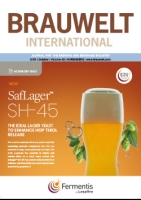Methods based on image analysis are flexible, rapid tools enabling both the elevator company and the maltster to monitor and adapt their processes. Thus, image analysis is a suitable technique for integrated chain control in the barley-malt-beer chain. TNO Nutrition and Food Research Institute has assessed a number of image analysis systems for their usefulness in collection and malting of barley.
Beer quality is determined by proper yeast treatment and propagation of pure yeast cultures. This paper deals with essential requirements.
Huge attention has been paid over the years to the ambition of achieving prolonged shelf life in beer. In the context of haze life, this can be achieved, provided a brewer is conscientious and willing to invest some money in achieving the goal.
Change and cost pressures have dominated the brewing sector in recent years. Restructuring and rationalisation reoccur in increasingly shorter cycles: Companies are becoming "leaner". Analytical laboratories in breweries and thus the actual quality control have not remained untouched by these developments.
hat must be done in order to keep pace with developments - in order to achieve the highest level of efficiency by using the means available in the most productive way, without endangering product quality at any time and in any way whatsoever. On the contrary, in the present jostling for competitive advantage, every possible means have to be employed in order to push product quality to the highest possible level and keep it there constantly.e.e.
....
A calcium oxalate precipitate in the bottle can lead to feared gushing, but in principle it can be avoided. The causes and conditions that lead to calcium oxalate precipitation are known. Yet difficulties with the phenomenon crop up repeatedly.
Practical experience gained in past years has shown that the sole cause of gushing problems was frequently calcium oxalate precipitations. This article examines the background and conditions as well as giving practical instructions on how to avoid calcium oxalate precipitation. Since the topic is a very extensive one, this article is being published in two parts. The second part will deal in particular with calcium oxalate problems in wheat beers produced by bottle fermentation.
....
Following introduction of the aniline index (AI) as an analytical tool in breweries, further investigations were carried out, aimed at finding new uses and deriving more information from the index.
Methodology, the train from mashing-in to storage tank, as well as the behaviour (rise) of the AI during storage of pale bottom fermented beers as a function of temperature and duration were described in a first report (1). A supplementary note: All analytical instruments should always be cleaned carefully (last rinse always with double-distilled water or chromatographic water) as analyses take place in the trace concentration region.
Increase of AI in whirlpool
Fig. 1 shows the increase of the AI and TBI (2) resulting from the wort rest in the whirlpool. 2 and 3).e...
In sterilisation of liquids, it is always necessary to strike a balance between the highest possible degree of safety and minimum side effects. This is particularly difficult because continuous monitoring of sterilisation requirements and the effect of sterilisation is not possible using conventional methods.
A hybrid sterilisation system, generating oxygen radicals, combines the highest sterilisation effect together with continuous monitoring and adjustment of the sterilising level to actual requirements.
Sterilisation - state-of-the-art
Liquids such as drinking and process water can be sterilised in various ways, e.g.:
- Disinfectant chemicals,
- UV sterilisation,
- heat;
- ultrasonic methods,
- filtration.e.g.).e.
....
A new analytical parameter, the aniline index (AI), has been introduced for determining thermal stress exposure of pale lagers. Determination of the AI is relatively straightforward. A rotary evaporator and a spectrophotometer are the only instruments required.
Relatively short-term thermal influences (hot filling, flash pasteurisation, pasteurisation) can be picked up in beer by determining the reduction or absence of certain enzymic activities. When evaluating longer term or intensive thermal effects (e.g. forced staling), apart from sensory methods, quantitative determination of thermal indicators (e.g. 2-furfural, gamma-nonalacton) can be considered, using chromatographic methods, after suitable preparation of beer samples (e.g. 1).6 cm).
....
The physiological state of the yeast and the quality of green beer in the yeast suspension do not remain unchanged during yeast propagation under aerobic conditions. The priority objective should therefore not be related to the highest achievable propagation rates. An extensive test series in a pilot fermenter was carried out with the objective of optimising the process.
Many production units have started to use propagator technology for aerobic propagation of pitching yeast in recent years. Numerous authors (1, 2, 3, 4, 5, 6, 7) have detailed the advantages associated with this technology, as compared to conventional, batch-wise propagation under low-oxygen conditions.5 - 4, propagation factors of 15 - 20 can be achieved when using aerobic propagation technology.
....
In recent years, many different regimes for aerobic yeast propagation have become established in breweries. Mode of aeration, mixing of contents and suppression of foam account for the major differences in the various systems offered by suppliers. When designing a yeast propagation plant, very different aspects often play a part. In any case, top priority should be given to an optimal yeast crop. Planning and design of a plant for aerobic yeast propagation must thus take account of the needs of the yeast.
It is well known that Ca-oxalate precipitates act as crystallisation nuclei. Carbon dioxide is set free at these nuclei, this may contribute to gushing of beer and may also reinforce this phenomenon. This article describes factors promoting formation of Ca-oxalate crystals and the possibilities of taking preventative measures.
Calcium has a special significance when it occurs together with oxalic acid and can form with the latter calcium precipitates (Ca-oxalate) in beer. In addition to the accepted factors such a fusaria infestation of barley or malt, also referred to as "malt-based" gushing, or excessive iron concentrations in bottled beer, these Ca-oxalate precipitates are regarded increasingly as possible contributors to gushing. 3).
....


